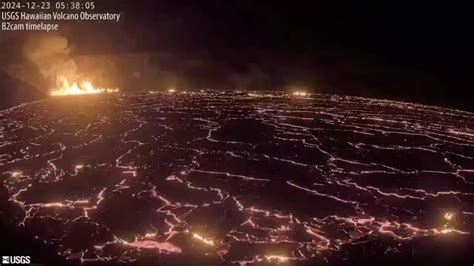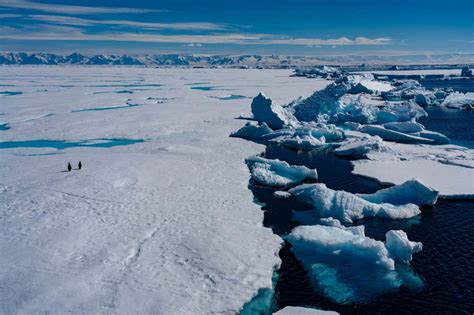
Kilauea volcano on the Big Island of Hawaii erupted on Sunday, creating a dazzling lava fountain display within Halemaʻumaʻu crater at the summit. The eruption, which began around 3:15 p.m. HST, has been contained within the crater and poses no immediate threat to nearby communities, according to the U.S. Geological Survey (USGS).
The USGS Hawaiian Volcano Observatory (HVO) reported the eruption commenced with increased seismic activity and elevated ground deformation. “The eruption began at approximately 3:15 p.m. HST on June 2, 2024, within Halemaʻumaʻu crater at the summit of Kīlauea,” the HVO stated in its initial assessment. The event was characterized by a surge of lava erupting from vents on the crater floor, creating impressive lava fountains reaching heights of several meters.
The eruption is occurring within a closed area of Hawai’i Volcanoes National Park. As a result, the general public is safeguarded from direct hazards associated with the eruption. However, park officials have closed several trails and viewpoints to ensure visitor safety and manage potential hazards such as volcanic gases and unstable ground conditions.
“We are closely monitoring the eruption and will provide updates as conditions change,” said a USGS spokesperson. The HVO is maintaining constant surveillance of Kilauea through visual observations, seismic monitoring, gas measurements, and drone overflights to assess the eruption’s intensity and potential hazards.
Volcanic Activity Details
The initial phase of the eruption involved a rapid increase in lava effusion rates. Lava fountains were observed reaching heights of 10-15 meters (33-49 feet) initially, creating a dynamic and visually striking display. The lava is accumulating within Halemaʻumaʻu crater, reshaping the crater floor and potentially interacting with older lava flows.
The USGS has emphasized that the eruption is confined to the summit crater, which significantly reduces the risk to populated areas. Previous Kilauea eruptions, such as the 2018 lower East Rift Zone eruption, caused widespread damage and displacement. However, the current eruption’s location mitigates the potential for similar impacts.
“Based on past eruptive behavior, the current activity could persist for hours to days,” the HVO noted. The duration and intensity of the eruption will depend on factors such as magma supply, gas content, and vent geometry. Scientists are closely analyzing these parameters to forecast the eruption’s future course.
Monitoring and Assessment
The HVO is employing a suite of monitoring tools to track the eruption’s progress. Seismic sensors are detecting ground vibrations associated with magma movement and lava effusion. Gas sensors are measuring the release rates of sulfur dioxide (SO2) and other volcanic gases, which provide insights into the magma’s composition and degassing processes.
Drone overflights are providing high-resolution imagery of the eruption site, allowing scientists to map lava flows, assess vent locations, and monitor changes in the crater’s morphology. Thermal cameras are also being used to measure the temperature of lava flows and identify areas of intense heat flux.
The USGS is collaborating with Hawai’i Volcanoes National Park to manage access to the eruption area and ensure visitor safety. Park rangers are enforcing closures of trails and viewpoints that are located near the summit of Kilauea. Information about closures and safety guidelines is being disseminated through the park’s website and visitor centers.
Potential Hazards
While the eruption is currently contained within Halemaʻumaʻu crater, there are several potential hazards that could arise. These include:
- Volcanic Gases: Eruptions release gases such as sulfur dioxide (SO2), carbon dioxide (CO2), and hydrogen sulfide (H2S). SO2 can react with moisture in the air to create volcanic smog (vog), which can cause respiratory problems, especially for individuals with asthma or other pre-existing conditions. CO2 is a colorless and odorless gas that can accumulate in low-lying areas and displace oxygen, potentially leading to asphyxiation.
- Lava Flows: Although the current eruption is confined to the summit crater, changes in eruptive activity could lead to lava flows that extend beyond the crater rim. Lava flows can destroy infrastructure, disrupt transportation routes, and pose a significant threat to human life.
- Ashfall: Explosive eruptions can generate ash plumes that drift downwind, depositing ash over broad areas. Ashfall can disrupt air travel, contaminate water supplies, and cause respiratory problems. The likelihood of significant ashfall from the current eruption is considered low, but it remains a potential hazard.
- Ground Deformation: Magma movement beneath the surface can cause ground deformation, including inflation (uplift) and deflation (subsidence). Ground deformation can trigger landslides and rockfalls, especially in areas with steep slopes.
- Projectile Hazards: Explosive eruptions can eject rocks and other debris into the air, posing a projectile hazard to anyone in the vicinity. The risk of projectile hazards is highest near the active vents.
Background on Kilauea Volcano
Kilauea is one of the world’s most active volcanoes and has been erupting nearly continuously for decades. The volcano is located on the southeastern flank of Mauna Loa, the largest volcano on Earth. Kilauea’s name means “spewing” or “much spreading” in the Hawaiian language, reflecting its frequent eruptive activity.
The volcano’s summit caldera, which contains Halemaʻumaʻu crater, has been the site of numerous eruptions throughout history. Halemaʻumaʻu crater has undergone significant changes in recent years, including the formation of a large lava lake that persisted for several years before draining in 2018.
The 2018 Kilauea eruption was one of the most destructive in recent history. The eruption began with the collapse of the Puʻu ʻŌʻō vent on the East Rift Zone, followed by the opening of numerous fissures in the lower East Rift Zone. These fissures erupted lava that destroyed hundreds of homes and displaced thousands of people. The eruption also caused significant changes to the landscape, including the creation of new black sand beaches and the expansion of the coastline.
Since the 2018 eruption, Kilauea has experienced several smaller eruptions within Halemaʻumaʻu crater. These eruptions have helped to rebuild the lava lake and reshape the crater floor. The current eruption is part of this ongoing process of volcanic activity.
Impact on Hawai’i Volcanoes National Park
Hawai’i Volcanoes National Park is a major tourist destination, attracting visitors from around the world who come to witness the power and beauty of Kilauea volcano. The park offers a variety of hiking trails, scenic overlooks, and visitor centers that provide opportunities to learn about the volcano’s geology and history.
The current eruption is impacting the park in several ways. The closure of trails and viewpoints near the summit of Kilauea is limiting access to some of the park’s most popular attractions. However, the eruption is also providing visitors with a unique opportunity to witness volcanic activity firsthand.
Park officials are working to balance the need to protect visitor safety with the desire to provide access to the eruption area. They are closely monitoring the eruption and adjusting access restrictions as needed. The park’s website and visitor centers are providing up-to-date information about closures and safety guidelines.
Broader Implications
The eruption of Kilauea volcano has broader implications for the study of volcanism and the understanding of Earth’s dynamic processes. Scientists are using data from Kilauea to improve their models of volcanic eruptions and to better forecast future eruptions.
The eruption is also raising awareness about the hazards associated with living near active volcanoes. It is a reminder that volcanoes are powerful forces of nature that can have significant impacts on human communities.
The ongoing activity at Kilauea provides valuable insights into the workings of volcanoes and the processes that shape our planet. By studying Kilauea, scientists can gain a better understanding of volcanism and its role in Earth’s history and future.
Quotes from Officials and Experts
- “The eruption began at approximately 3:15 p.m. HST on June 2, 2024, within Halemaʻumaʻu crater at the summit of Kīlauea,” – USGS Hawaiian Volcano Observatory (HVO)
- “We are closely monitoring the eruption and will provide updates as conditions change,” – USGS Spokesperson
- “Based on past eruptive behavior, the current activity could persist for hours to days,” – HVO
Frequently Asked Questions (FAQ)
- Is the eruption of Kilauea dangerous to residents?
- Currently, the eruption is contained within Halemaʻumaʻu crater at the summit of Kilauea, inside Hawai’i Volcanoes National Park. This location significantly reduces the risk to populated areas. However, volcanic gases, lava flows (should the eruption intensity increase and spill over the crater), and potential ashfall are potential hazards that are being closely monitored. The USGS and National Park Service are providing regular updates and safety guidelines to the public.
- Where is the eruption taking place?
- The eruption is occurring within Halemaʻumaʻu crater, which is located at the summit of Kilauea volcano inside Hawai’i Volcanoes National Park on the Big Island of Hawaii.
- How long is the eruption expected to last?
- Based on past eruptive behavior, the USGS Hawaiian Volcano Observatory (HVO) suggests that the current activity could persist for hours to days. The duration and intensity will depend on various factors, including magma supply and gas content.
- What kind of monitoring is being used to track the eruption?
- The HVO is utilizing a comprehensive suite of monitoring tools, including seismic sensors to detect ground vibrations, gas sensors to measure volcanic gas emissions (like sulfur dioxide), drone overflights to capture high-resolution imagery and thermal data, and visual observations.
- What parts of Hawai’i Volcanoes National Park are closed due to the eruption?
- Several trails and viewpoints near the summit of Kilauea have been closed to ensure visitor safety. The Hawai’i Volcanoes National Park website and visitor centers provide up-to-date information on specific closures and safety guidelines.
- What caused the eruption?
- The eruption is a result of magma rising from the Earth’s mantle to the surface. Kilauea is one of the world’s most active volcanoes, and its frequent eruptions are part of a long-term pattern of volcanic activity related to the Hawaiian hotspot. Changes in pressure within the magma chamber and pathways to the surface can trigger eruptions.
- What are the main hazards associated with the eruption?
- The main hazards include volcanic gases (such as sulfur dioxide, which can cause respiratory problems), potential lava flows if the eruption increases in intensity, ashfall (though the likelihood is currently low), ground deformation, and projectile hazards near the active vents.
- How is the local community being informed about the eruption?
- The USGS and Hawai’i Volcanoes National Park are providing regular updates through their websites, social media channels, and press releases. Local news outlets are also reporting on the eruption, and park rangers are providing information to visitors at visitor centers.
- Was there any warning before the eruption?
- Yes, the USGS Hawaiian Volcano Observatory (HVO) detected increased seismic activity and ground deformation prior to the eruption, which served as indicators that an eruption was imminent.
- What are the long-term impacts of the eruption likely to be?
- The long-term impacts will depend on the duration and intensity of the eruption. Continued activity within Halemaʻumaʻu crater could reshape the crater floor and contribute to the ongoing rebuilding of the lava lake. More significant eruptions could have broader impacts on the landscape and potentially affect air quality and access to certain areas within Hawai’i Volcanoes National Park.
- How does this eruption compare to the 2018 eruption of Kilauea?
- The current eruption is significantly different from the 2018 eruption. The 2018 eruption was a major event that involved the collapse of the Puʻu ʻŌʻō vent on the East Rift Zone and the opening of numerous fissures in the lower East Rift Zone, resulting in widespread destruction and displacement. The current eruption is contained within Halemaʻumaʻu crater at the summit and poses a much lower risk to populated areas.
- What is the role of the Hawaiian Volcano Observatory in monitoring the eruption?
- The Hawaiian Volcano Observatory (HVO) is responsible for monitoring Kilauea and other Hawaiian volcanoes, assessing volcanic hazards, and providing timely information to the public and emergency management agencies. The HVO uses a variety of monitoring techniques, including seismic monitoring, gas measurements, deformation measurements, and visual observations, to track volcanic activity and forecast future eruptions.
- What types of gases are being released by the eruption and what are their potential health effects?
- The eruption is releasing gases such as sulfur dioxide (SO2), carbon dioxide (CO2), and hydrogen sulfide (H2S). Sulfur dioxide can react with moisture in the air to create volcanic smog (vog), which can cause respiratory problems, especially for individuals with asthma or other pre-existing conditions. Carbon dioxide is a colorless and odorless gas that can accumulate in low-lying areas and displace oxygen, potentially leading to asphyxiation. Hydrogen sulfide is a toxic gas that can cause irritation to the eyes, nose, and throat.
- How is the eruption affecting air quality in the surrounding areas?
- The eruption is releasing sulfur dioxide (SO2), which can contribute to volcanic smog (vog). Vog can affect air quality and cause respiratory problems, especially for individuals with pre-existing conditions. The extent of the impact on air quality depends on factors such as the amount of SO2 released, wind direction, and weather conditions. The Hawaii Department of Health monitors air quality and provides information to the public about vog conditions.
- What advice is being given to people with respiratory problems?
- People with respiratory problems, such as asthma or chronic obstructive pulmonary disease (COPD), are advised to take precautions to protect themselves from volcanic smog (vog). These precautions include staying indoors, closing windows and doors, using air purifiers, and avoiding strenuous activities. It is also important to have an adequate supply of medications on hand and to consult with a healthcare provider if symptoms worsen.
- Are there any financial assistance programs available for businesses or individuals affected by the eruption?
- Financial assistance programs may be available for businesses or individuals affected by the eruption, depending on the extent of the impact and the availability of funding. Potential sources of assistance include the Small Business Administration (SBA), the Federal Emergency Management Agency (FEMA), and state and local government agencies. Information about available assistance programs can be found on the websites of these agencies.
- How is the eruption affecting tourism on the Big Island?
- The eruption is having a mixed impact on tourism on the Big Island. The closure of trails and viewpoints near the summit of Kilauea is limiting access to some of the park’s most popular attractions. However, the eruption is also providing visitors with a unique opportunity to witness volcanic activity firsthand, which may attract some tourists. The overall impact on tourism will depend on the duration and intensity of the eruption and the availability of alternative attractions.
- What measures are being taken to protect wildlife and ecosystems in the park?
- The National Park Service is taking measures to protect wildlife and ecosystems in the park from the impacts of the eruption. These measures include monitoring air quality and water quality, protecting sensitive habitats, and controlling invasive species. The park is also working to educate visitors about the importance of protecting the environment.
- What are the different types of lava that Kilauea produces?
- Kilauea primarily produces two types of lava: pāhoehoe and ʻaʻā. Pāhoehoe lava is smooth, ropy lava that flows easily and forms broad, gently sloping surfaces. ʻAʻā lava is rough, jagged lava that flows more slowly and forms steep, rubbly surfaces. The type of lava that is produced depends on factors such as the lava’s viscosity, gas content, and flow rate.
- How can I stay informed about the eruption and any potential hazards?
- You can stay informed about the eruption and any potential hazards by following the USGS Hawaiian Volcano Observatory (HVO) and Hawai’i Volcanoes National Park on their websites and social media channels. You can also monitor local news outlets and heed any warnings or instructions issued by emergency management agencies. It is important to be aware of the potential hazards and to take appropriate precautions to protect yourself and your family.
Additional Context and Analysis
The recent eruption of Kilauea offers scientists a valuable opportunity to study the volcano’s behavior and improve their understanding of volcanic processes. The data collected during the eruption will be used to refine models of magma movement, gas emissions, and lava flow dynamics. This information will help to better forecast future eruptions and mitigate the associated hazards.
The eruption also highlights the importance of volcano monitoring and hazard assessment. The USGS Hawaiian Volcano Observatory’s continuous monitoring of Kilauea allowed them to detect the increased seismic activity and ground deformation that preceded the eruption, providing valuable warning time. This underscores the need for continued investment in volcano monitoring infrastructure and research.
The event also serves as a reminder of the dynamic nature of volcanic landscapes and the ongoing need to adapt to the challenges posed by living near active volcanoes. Communities living near Kilauea and other active volcanoes must be prepared for the possibility of future eruptions and take steps to mitigate the associated risks. This includes developing evacuation plans, building resilient infrastructure, and educating the public about volcanic hazards.
The eruption is also a reminder of the cultural significance of volcanoes to the Hawaiian people. Kilauea is considered a sacred place by many Native Hawaiians, and its eruptions are seen as expressions of the power and creativity of the volcano goddess Pele. The eruption provides an opportunity to reflect on the cultural and spiritual connections between people and volcanoes and to promote respect for the natural environment. The balance between scientific study, public safety, and cultural sensitivity is critical in managing volcanic events in Hawaii.
Future Outlook
The future outlook for Kilauea volcano remains uncertain. While the current eruption is contained within Halemaʻumaʻu crater, there is always the possibility that the activity could change. Scientists will continue to monitor the volcano closely and provide updates to the public as conditions evolve. The possibility of future eruptions, both within the summit crater and along the East Rift Zone, cannot be ruled out. Preparedness and continuous monitoring are essential for managing the risks associated with living near an active volcano.









